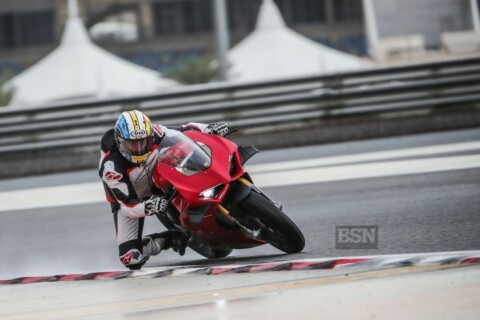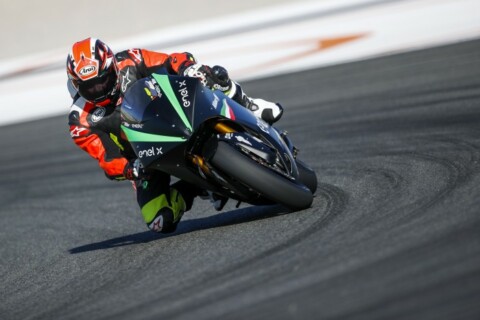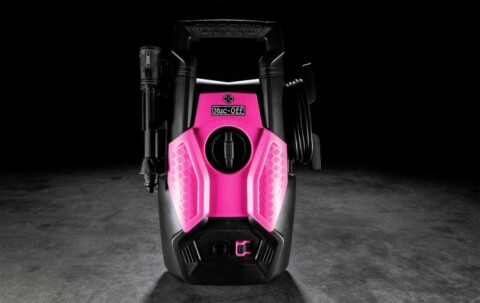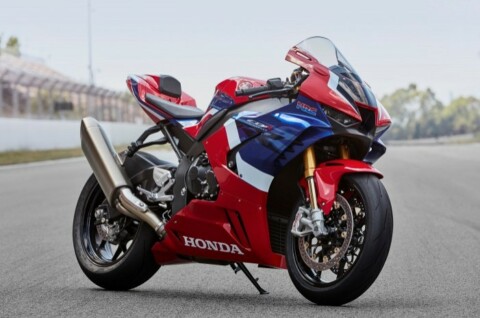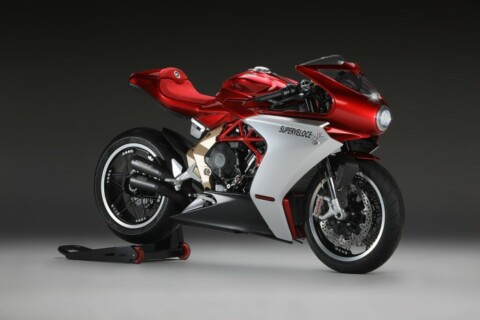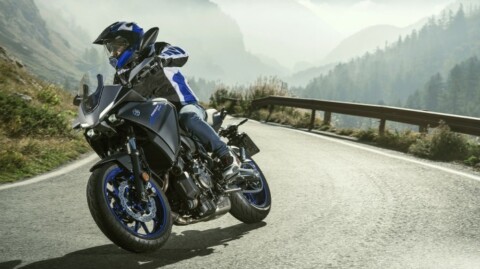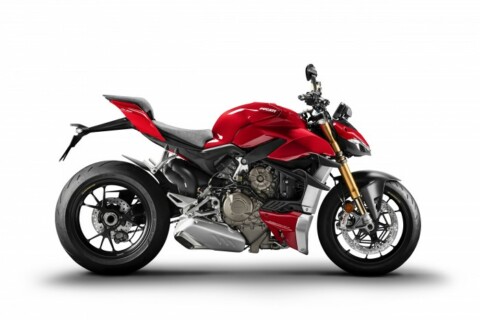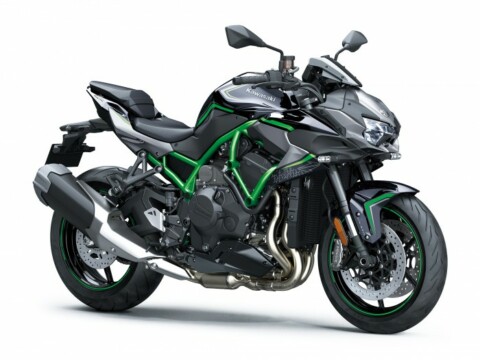Due to an oversight on Yamaha’s part, bikesportnews.com’s invite to Eastern Creek (or Sydney Motorsport Park as it is now known) for the 2015 Yamaha R1 launch failed to materialise – the dog ate it or something - so we woke up former MotoGP and WSBK racer Steve Martin, also a World Endurance Champion, and sent him to see what all the fuss is about…
I still remember the day I saw the first R1. It was way back in 1998, I was at Mallala raceway in South Australia racing a Ducati but when I saw that Yamaha I knew the Japanese company was getting serious again.
I raced an ‘07 in WSBK, the ‘08 Model in World Endurance and in ‘09 we received the first of the big bang models which was to be our tool again to try and win the World Endurance title. We managed to do that and win the championship first time out which was an amazing credit to Yamaha and the development team. The problem with the first generation big bang was, however, that in street form it was very restricted which made it a little slow compared to the competition. It was also a little wide and a little heavy but in full race trim it was a bike that could win races with ease just like its more refined brother the M1.
This is a test that I have been long looking forward to. The first thing to say about the 2015 model is that it’s a completely new machine from the ground up. Yes it is still an inline-four and yes it’s still got that big bang engine configuration but that is where the similarity stops. The specifications of the new model spell that out loud and clear. There’s more though, not only did the boffins design one mode, there’s another alongside. Yes that’s right one for the street and one for the street or serious track day rider called the M. We were lucky enough to get to complete six twenty minute sessions of Eastern Creek on both the standard R1 and the street racer the M model.
We started in the morning with the KYB equipped standard machine first fitted with Bridgestone 190 RS 10 RR rear and the matching 120 70 RS10FR front. These tyres aren’t original equipment but were a step sportier for sport road riding and edging into track use and obviously fitted as this was a track-only launch.
The bikes were set up as standard with show room floor settings on the first outing as the guys from Yamaha wanted us to feel the standard bike and adjust it from that point. Heading down pit lane for the first time made me feel like a boy again. I always loved the noise of the crossplane crank with its unique burble. Even with the standard pipe I felt like I was on a race bike. The lack of clutter, hidden headlights and indicators all make this R1 feel race-prepped out of the box.
Once under way we had to follow the Yamaha test rider for a couple of laps at a sensible pace which was great as it gave me a good opportunity to mould in to the seat and get comfortable. I found the bike ergonomically friendly, being your average size rider. I didn’t hear too many grumbles from the taller guys either so I think Yamaha have found a good compromise to suit most size sand structure.
On those first couple of laps at a sedate pace I had a chance to peruse the ultra-modern dash which was set to track mode giving you a more race orientated setting with a lap timer option and a tacho which reads from 8000rpm up to the redline at fourteen grand. I checked the mode switches for positioning and so forth. Yamaha have put a lot of thought into the layout of the switchgear which are so much more important than they were a few years ago. You see, a lot of the tuning of this motorcycle’s electronic package is done through the handlebars and with the amount of adjustments available you need an easy system to tailor this to your personal taste.
As the pace picked up the first thing that became apparent was the engine. The narrower more refined and four-kilo lighter engine is fast. It’s much faster than the old model with a very linear power band and plenty of it. My bike was in power map three at the initial exit which is a softer delivery but never the less I really liked the throttle feel as it made the connection to the rear wheel very smooth opening and closing the gas. The other thing I noticed was how easy handling the bike was.
It’s a bike you can get on and just ride. It’s a flat handling machine and what I mean by that is that it doesn’t pitch forward and back under acceleration or braking like some others do. Flat handling bikes are usually easier to wrestle around than bikes with pitch built in to them as the rider position has less effect and it means the bike is more stable as well. I have to say at this point I was surprised by the feel of the Bridgestone tyres as I had ridden on some a couple of years ago and they scared me. These on the other hand had a great deal of feel and more grip than I was expecting for a tyre not narrowly focused on winning races. As I went faster the standard settings of the KYB shock and fork started to be a little too soft. This caused the bike to run wide and wallow a little at some of the hard accelerating exits.
During session one and two I made some setting changes which included stiffening the front and rear suspension to aid in keeping the bike at the right attitude. The KYB technicians didn’t do anything radical just added some more damping clickers front and rear and a couple of mm of rear spring preload on the rear to stop the bike from wallowing. I was then really able to appreciate the handling of the R1 with its suspension set correctly for the conditions. The wallowing stopped and the fun began. I’m glad I rode the bike soft first though as it really bought home the fact of how adjustable the bike is and how when you do make changes they affect the motorcycle. That’s a good thing and the way good race bikes are made.
Now the handling was sorted for my style and speed, I turned my attention to the electronics. This bike has an electronic package derived from the 2012 M1 race bike which makes it cutting edge and quite involved. There are four preset power mode settings which means although the system is highly adjustable you don’t need to play with anything and can just choose one of those STD maps and ride if you so choose.
The big thing about the electronics this year is the way in which this motorcycle measures its position related to the ground by using G sensors and Gyro sensors. These sensors measure pitch in all directions and roll left and right so the ecru knows exactly where this bike is sitting in relation to the road.
This positioning is important as there are so many adjustable components to play with that without IMU most of the software wouldn’t work. Running through the list there are 7 major adjustable components and that is a massive increase on the old R1:
Traction control with nine different stages
Slide control which which works in conjunction with traction and alters the engine output when a slide is detected at the rear
LIF which is a three-setting plus off button anti wheelie control
A quick shift system with two settings which works great
Launch control which works just like a GP bike
A new ABS system which works extremely well and this is combined with the new Unified braking system which links the rear brake to the front
Four different power mode systems which alter the throttle to butterfly connection allowing you to alter the connection feeling between hand and rear wheel
All of these settings are actually quite easy to change as well with Yamahas new Ride Control System which groups all the adjustable components on to an easy to read table for you so you know where everything is at. It really is a little like play station but I loved the tech side of this bike.
For my last morning session I dialed the settings of the electronics back and reduced wheelie control, left the slide control on level three and power mode on level two. I found this to be quite a good track setting and it allowed me to go even faster but it was definitely at the expense of some safety feeling that I had from the combination of the standard settings.
My last outing on the standard R1 was pretty much a scrap with Cameron Donald and we weren’t holding back. I was pretty happy with the R1 and the adjustments I had made over the course of the morning. I wish I had more time with the suspension as at warp speeds it needed more adjustment but it was lunch time and more importantly time to get on the M model.
As soon as I tipped in to turn two I knew I wanted the M. The bike’s Ohlins suspension was just race track ready. I definitely had a lot more bump absorption especially when my knee was on the ground and a lot more turn as well. On the M, I was a lot quicker than I had been in the morning with the standard machine. I didn’t touch the suspension and just dialed my preferred electronic settings on to the machine. The ERS, Electronic Racing Suspension has a manual and auto setting which adjusts the suspension automatically depending on the situation the bike is in. Yamaha in conjunction with Ohlin’s have done a great job because it is a sophisticated system but it is a system that you can set and forget and it will just work. You would think that it would be harsher than the KYB standard equipment but due to the ERS it’s actually more compliant at cruising speeds too.
The other cool thing about the R1M is it comes with CCU which is a communication control unit that allows data to be transferred from your smart phone or a tablet to the bike. Yes that’s right sit in the lounge and set the bike up.
Other points of interest to me were that the engine brake on both models was perfect with no backing in due to changing back through the gears. The new clutch which is lighter and smaller only has three springs also played a part with its slipper qualities but also there has to be some electronic aid helping out there too.
The brakes were fine on both models at standard speeds with good feel but on very heavy stopping I felt I had to use too much lever pressure to pull the bike up. Perhaps a pad change will fix this but I’m talking finer points here. Another thing I would do is change the footpeg hangers as when things start to get really serious I found my feet dragging a little which is no big issue but a point to mention.
In the end I really enjoyed the chassis and understood how good this bike is as a standard package. We only had R1s on track so it’s impossible for anyone to say at this stage if this bike is the fastest 1000 sportsbike on the market but it’s certainly going to give it a good nudge. Would I buy one I found myself asking myself at the end of the day. Hmmmm. I always did like the letter M.


